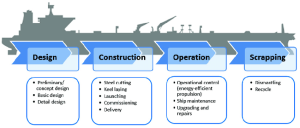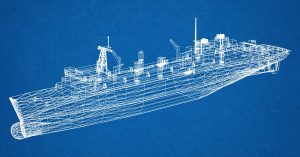Introduction to Ship Design
The maritime industry is a cornerstone of global trade, transportation, and economic development. At its core lies the intricate process of ship design, a multidisciplinary endeavor that blends engineering, technology, and creativity. Ship design is not merely about creating a vessel that floats; it ensures safety, efficiency, sustainability, and compliance with international regulations.
Ship design is a complex, iterative process that transforms a concept into a fully functional vessel. It requires collaboration among naval architects, marine engineers, designers, and stakeholders to balance functionality, aesthetics, and performance. The design process is divided into several stages, each with its own objectives, challenges, and deliverables.

Understanding these design stages is essential for anyone involved in the maritime industry, from students to professionals:
1. Conceptual Design Stage
The conceptual design stage lays the foundation for the entire ship design process. It begins with defining the vessel’s purpose, key requirements, and overall specifications. During this phase, naval architects address fundamental questions such as the ship’s primary function (e.g., cargo transport, passenger cruise, or offshore operations), size, capacity, speed requirements, and environmental or regulatory constraints.
Preliminary sketches and feasibility studies are created, focusing on aspects like hull shape, propulsion systems, and stability. The goal is to develop a basic design concept that aligns with the client’s needs while adhering to safety and regulatory standards. This stage sets the direction for all subsequent design work.
2. Preliminary Design Stage
Once the conceptual design is approved, the process advances to the preliminary design stage. This phase refines the initial concept and delves into technical details. Engineers and designers optimize the hull form for hydrodynamics, ensuring minimal resistance and maximum fuel efficiency. Stability and load analyses are performed to guarantee the ship’s safety under various conditions.
The selection of propulsion and power systems is another critical aspect of this stage. Engineers choose engines, propellers, and other machinery based on the ship’s operational requirements. Sustainability is also a key consideration, with designers exploring eco-friendly technologies such as hybrid propulsion systems or energy-efficient materials. By the end of this stage, the design team has a clearer vision of the ship’s technical specifications and performance capabilities.
3. Contract Design Stage
The contract design stage serves as the bridge between the preliminary design and the final construction plans. It involves creating detailed drawings and specifications that form the basis of the contract between the shipowner and the shipyard. During this phase, the structural design is finalized, defining the ship’s framework, including bulkheads, decks, and compartments.
Systems integration is another focus, as engineers plan the layout of electrical, mechanical, and piping systems. Regulatory compliance is ensured by adhering to international standards set by organizations like the International Maritime Organization (IMO) and classification societies such as Lloyd’s Register or DNV. Cost estimation and risk assessment are also conducted to ensure the project remains within budget and timeline.
4. Detailed Design Stage
The detailed design stage is the most intensive phase of the ship design process. It involves creating highly detailed plans and specifications that guide the vessel’s construction. Using computer-aided design (CAD) software, designers develop a 3D model of the ship, allowing for precise visualization and analysis. Material selection is critical, as engineers choose materials that meet strength, durability, and weight requirements.
Individual components, such as rudders, anchors, and winches, are designed with exact dimensions and tolerances. Collaboration with the shipyard is essential during this stage to ensure the design is feasible and can be constructed efficiently. By the end of this phase, the shipyard has all the necessary information to begin construction.
5. Construction and Production Design Stage
The construction and production design stage focuses on preparing the shipyard for the actual building of the vessel. Production planning involves developing a construction schedule and workflow to optimize efficiency. Workshop drawings are created, providing detailed instructions for each section of the ship, including welding plans and assembly procedures.
Quality control is a top priority, with established procedures to ensure the ship is built to the highest standards. The design team works closely with the shipyard to address any challenges that arise during construction, ensuring the project stays on track.
6. Post-Design and Testing Stage
Once construction is complete, the post-design and testing stage begins. This phase ensures the vessel meets all design specifications and regulatory requirements. Sea trials are conducted to evaluate the ship’s performance, including speed, maneuverability, and stability. System testing verifies the functionality of all onboard systems, such as navigation, communication, and safety equipment.
Final inspections are carried out to ensure compliance with international standards. Any issues identified during testing are addressed before the ship is delivered to the owner. This stage marks the culmination of the ship design process, resulting in a fully functional vessel ready for operation.
The Future of Ship Design
The maritime industry is evolving rapidly, driven by advancements in technology and the need for sustainability. Future ship designs will likely incorporate autonomous technologies, such as AI and automation for unmanned vessels, and green technologies, including alternative fuels like hydrogen and ammonia. Digital twins, virtual replicas of ships, will enable real-time monitoring and optimization, further enhancing efficiency and performance. These innovations will redefine the ship design process, making it more efficient, sustainable, and adaptable to changing industry needs. As the maritime industry continues to evolve, ship designers will face new challenges and opportunities, pushing the boundaries of innovation and sustainability.
The stages of ship design are a testament to the complexity and ingenuity of maritime engineering. From the initial concept to the final sea trials, each stage plays a critical role in creating vessels that are safe, efficient, and environmentally friendly. As the maritime industry continues to evolve, ship designers will face new challenges and opportunities, pushing the boundaries of innovation and sustainability.


